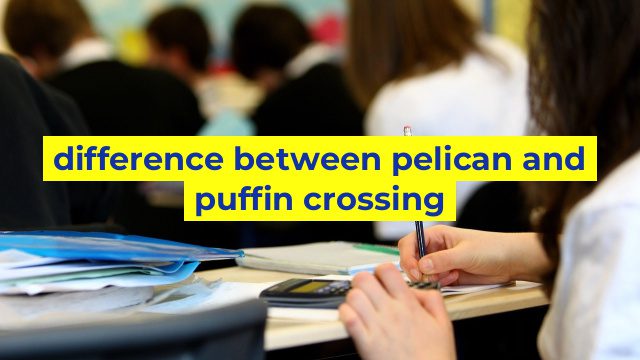Difference between Pelican and Puffin Crossing
When it comes to pedestrian crossings, there are two commonly used types – Pelican and Puffin. While they may look similar, they have some significant differences that are important to understand. In this article, we’ll explore the differences between Pelican and Puffin crossings, so you can identify which is which when you encounter them on the roads.
The Basics of Pelican Crossing
Pelican crossings are named after the “P.E.L.I.C.A.N.” acronym used to describe them, which stands for “Pedestrian Light Control Actuated”. Unlike other types of crossings, Pelican crossings are signal-controlled and rely on a button to activate the crossing lights.
When a pedestrian wants to cross the road at a Pelican crossing, they have to press a button located on the side of the road. This triggers a red light, which stops the vehicles, giving pedestrians the right of way to cross the road safely. Once the pedestrians reach the other side, the light turns green, indicating to the vehicles to continue on their way.
Pelican crossings are known for their long waiting times, particularly during peak traffic hours, as it takes a while for pedestrians to activate the crossing lights.
The Basics of Puffin Crossing
Puffin crossings, named after the “Puffin” acronym which stands for “Pedestrian User-Friendly Intelligent Crossing”, are the newer of the two types of crossings. Puffin crossings are also signal-controlled, but they are more advanced than Pelican crossings.
Puffin crossings have sensors and cameras that detect when someone is waiting to cross the road. This means that pedestrians don’t have to press a button to activate the crossing lights. The sensors also allow the crossing to be more flexible, as pedestrians don’t have to wait as long for the lights to change.
The sensors and cameras on Puffin crossings can also identify when a pedestrian is crossing the road. If a pedestrian takes longer than expected to cross the road, the sensors will adjust the crossing times to ensure that they have enough time to cross safely.
Key Differences between Pelican and Puffin Crossing
The main differences between Pelican and Puffin crossings are in their operation and technology. Pelican crossings are activated by a button, while Puffin crossings use sensors and cameras to detect pedestrians. Puffin crossings are also considered to be more flexible and user-friendly than Pelican crossings, as the sensors can adjust the crossing times for pedestrians.
Another key difference between the two types of crossings is the waiting time. As Pelican crossings rely on a button to activate the crossing lights, pedestrians may have to wait longer to cross the road. However, Puffin crossings are more efficient, as the sensors detect when people are waiting to cross, reducing waiting times.
Conclusion
In conclusion, while Pelican and Puffin crossings may seem similar, there are some key differences between them that are worth noting. Pelican crossings are activated by a button, rely on predetermined crossing times, and are considered less user-friendly than the newer Puffin crossings, which use sensors to detect pedestrians, adjust the crossing times, and provide more flexibility. Understanding these differences can help you choose the best crossing for your needs and stay safe while crossing the road.
Table difference between pelican and puffin crossing
| Feature | Pelican Crossing | Puffin Crossing |
|---|---|---|
| Operation | Push-button activated | Computer-controlled |
| Crossing Time | Fixed time regardless of pedestrians | Adjusts to pedestrian speed and behavior |
| Location | Usually located at busy intersections | Can be located at mid-blocks |
| Visual Signals | Separate red and green man signals | Green man on the same signal as vehicle traffic |
| Audio Signals | Available for visually impaired pedestrians | Available for visually impaired pedestrians |

